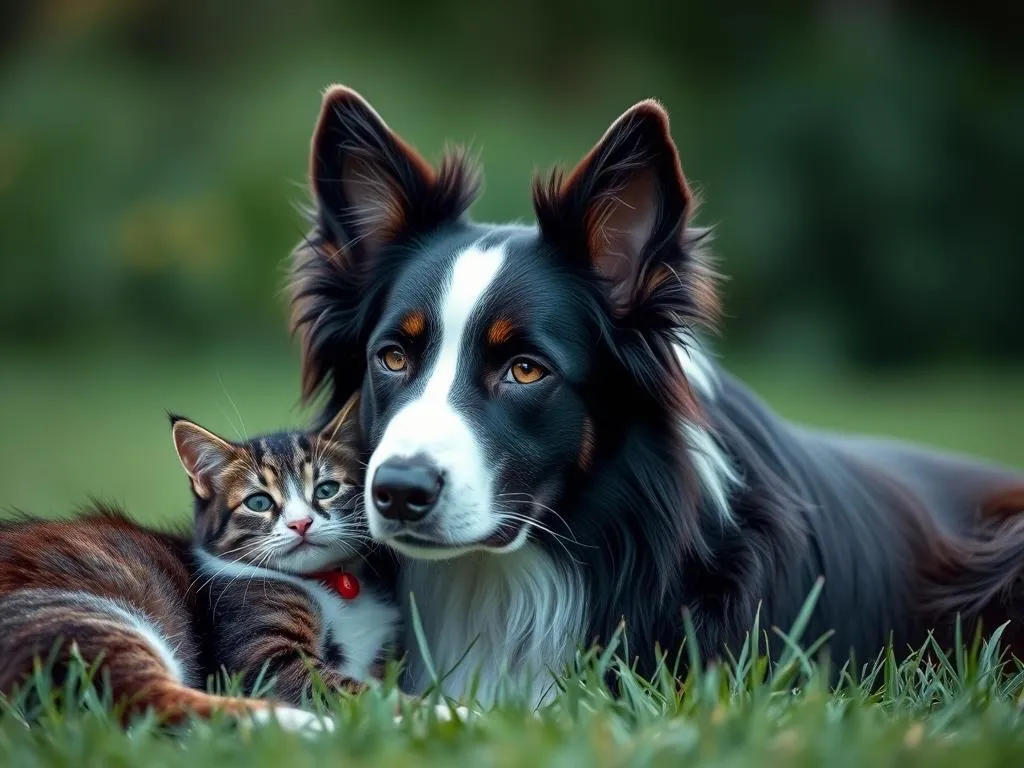
Introduction
The relationship between dogs and cats can be as complex as it is fascinating. In the United States alone, approximately 67% of households own a pet, with about 63 million households owning a dog and 42 million households having a cat. With such high numbers, understanding pet compatibility becomes essential for many pet owners.
One common query among dog owners, particularly those considering a Border Collie, is: “Will a Border Collie be good with my cat?” This article aims to provide a comprehensive overview of Border Collies, the dynamics of dog-cat relationships, the introduction process, potential challenges, and tips for fostering a harmonious coexistence.
Understanding Border Collies
Characteristics of Border Collies
Border Collies are renowned for their intelligence and energetic nature. As one of the most intelligent dog breeds, they excel in obedience and agility, making them popular among dog trainers and enthusiasts. Their temperament is generally friendly and loyal, but they also require plenty of mental and physical stimulation.
Physically, Border Collies are medium-sized dogs, typically weighing between 30 to 45 pounds. They have a distinctive double coat that can be either smooth or rough, with various color combinations, including black and white, red and white, and tricolor.
Behavioral Traits
Border Collies possess strong herding instincts, which can significantly influence their behavior around other animals, including cats. These instincts may manifest in chasing or nipping, particularly if the Collie perceives the cat as something to herd. However, Border Collies are also known for their social behaviors; they are usually friendly and willing to play with other pets if introduced correctly.
General Dog-Cat Dynamics
Common Misconceptions
Many people believe that dogs and cats are natural enemies, but this is not necessarily true. While it’s common for dogs to chase cats, the relationship can be harmonious with the right approach. Understanding the differences in behavior and instincts of both species helps debunk the myth that dogs and cats cannot coexist peacefully.
Factors Influencing Compatibility
Several factors influence the compatibility between a Border Collie and a cat:
- Individual Personality: Just as people have unique personalities, so do pets. Some dogs are more tolerant of cats, while others may have a stronger prey drive.
- Age and Socialization History: Puppies and kittens that are raised together are more likely to develop a bond. Older pets may struggle with accepting new companions.
- Environmental Factors: The living space can also play a role. A larger area with designated spaces for each pet can reduce territorial disputes and stress.
Introducing a Border Collie to a Cat
Preparation Before the Introduction
Before introducing a Border Collie to a cat, it’s crucial to prepare a safe environment. Ensure that both pets have their own spaces where they can retreat if they feel overwhelmed. Familiarize yourself with cat behavior; understanding signs of stress or aggression (like hissing or swatting) can help you manage the introduction effectively.
The Introduction Process
-
Initial Separation: Start by keeping the Border Collie and cat in separate rooms. Allow them to get used to each other’s scent by swapping bedding or toys.
-
Controlled Introduction: After a few days, bring them together in a controlled manner. Use a leash for the Border Collie, allowing the cat to explore at its own pace.
-
Supervision is Key: Always supervise their interactions, especially during the first few meetings. Look for positive signs, such as curiosity and calm behavior.
-
Short Sessions: Keep the initial meetings brief. Gradually increase the duration as they become more comfortable with each other.
Signs of a Successful Introduction
Successful introductions can be recognized by positive interactions, such as:
- Mutual curiosity without aggression.
- Occasional play between the two.
- Respect for each other’s space and boundaries.
Potential Challenges
Common Issues in Dog-Cat Relationships
While many dogs and cats can live together harmoniously, certain challenges can arise:
-
Predatory Instincts: Some dogs have strong prey drives, and it may pose a risk to cats. Observing the dog’s behavior and managing these instincts is crucial.
-
Territorial Behaviors: Both species can exhibit territorial behaviors. Dogs may bark or growl if they feel their space is being invaded, while cats may hiss if they feel threatened.
Border Collie-Specific Challenges
Border Collies bring their own set of challenges:
-
Herding Behavior: Their herding instincts can lead them to chase the cat, which may cause stress or fear. Understanding this behavior is crucial in preventing potential issues.
-
Managing Energy Levels: Border Collies are high-energy dogs requiring plenty of exercise and mental stimulation. If they are not adequately exercised, their excess energy may lead to inappropriate behaviors towards the cat.
Tips for Successful Coexistence
Training and Socialization
Training is critical for Border Collies, especially when adapting to a home with a cat. Basic commands like “sit,” “stay,” and “leave it” can help manage interactions. Socialization is equally important; exposing the Border Collie to various environments and other animals early on can foster a more adaptable and well-rounded pet.
Creating a Safe Space
Both pets should have their own safe spaces. For the cat, this can include cat trees or shelves that allow them to escape and observe from a height. For the Border Collie, designated areas for resting and play can help them feel secure.
Regular Monitoring and Adjustment
As your pets adjust to each other, monitoring their interactions is crucial. Keep an eye out for any signs of distress or aggression and be prepared to intervene if necessary. If issues arise, consider re-evaluating the introduction process and making adjustments.
Real-Life Experiences
Case Studies and Anecdotes
There are numerous success stories of Border Collies living peacefully with cats. One family reported that their Border Collie, after a few weeks of careful introductions, became best friends with their cat, often playing together in the yard.
Conversely, some families faced challenges, such as the dog’s strong herding instinct causing the cat to feel threatened. These owners found success by implementing structured training and ensuring the cat had plenty of escape options.
Expert Opinions
Veterinarians and animal behaviorists often emphasize the importance of gradual introductions and training. They recommend understanding each pet’s individual behavior and providing consistent reinforcement for positive interactions.
Conclusion
When considering whether a Border Collie will be good with my cat, it’s essential to understand both the breed’s characteristics and the dynamics of dog-cat relationships. With proper introductions, training, and the right environment, many Border Collies can coexist peacefully with cats.
Patience and understanding are key when fostering healthy relationships between pets. Every pet is unique, and their compatibility ultimately depends on individual personalities, socialization, and the effort put into creating a harmonious home.
By taking the time to educate yourself on the needs of both your Border Collie and your cat, you can create a loving and friendly environment for both pets.








